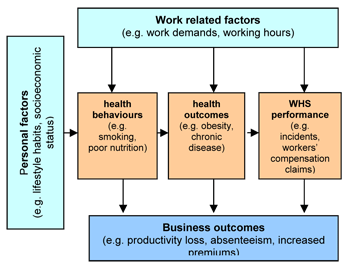Integrating health, safety and wellbeing
Addressing work health, safety and wellbeing together will support workers' health and reduce work-related injuries and illness.
Integrated approach
Integrated approaches to work health combine occupational safety and injury prevention with health and wellbeing to enhance worker health and prevent work-related injuries and illness.
The Principles of Good Work Design highlights that focusing on good work design and integrating and improving work health and wellbeing into that design can lead to improved business success through higher worker productivity.
Good work health and safety systems can easily incorporate work health and wellbeing risk management into existing policies and procedures, because the fundamental goals and principles are like safety.
Goals | Principles |
|---|---|
|
|
The relationship between work and health is reciprocal: good work contributes to preventing health issues, while good health enhances workers' productivity.
Designing Work for Health: Designing work with health in mind is essential to prevent various health issues, including musculoskeletal disorders, mental health problems, exposure to hazardous substances, and occupational diseases. Well-designed workplaces not only promote health but also support the early identification and prevention of chronic disease risks, facilitating quicker recovery and return to work after illness or injury.
Health Impact on Work:The overall physical and psychological health of a workforce significantly influences work health, safety, and wellbeing outcomes. Workers exposed to challenging conditions, stressful tasks, and extended work hours are more likely to engage in unhealthy behaviors like smoking, excessive alcohol consumption, low physical activity, and poor nutrition. Such workers also tend to experience higher rates of injury, illness, absenteeism, and presenteeism.
Shared Responsibilities: Everyone shares the responsibility for ensuring health and safety in the workplace, as outlined in the Work Health and Safety Act 2011. The Act defines health broadly, encompassing both physical and psychological well-being. Persons conducting a business or undertaking (PCBUs), officers, workers, and other individuals at a workplace all have specific duties to fulfill under the legislation. PCBUs, for instance, must ensure a safe work environment, while workers are obligated to take reasonable care for their own health and safety.
Managing Work Health: While there's no legislative mandate in Australia to explicitly integrate health, safety, and wellbeing, it is implied that workplaces have an obligation to prevent injury or illness. Managing chronic disease risks becomes a crucial aspect of influencing and improving worker health, safety performance, and overall business outcomes.
Interactive Model: The provided model illustrates how workplace factors impact worker health, health behaviors, and the safety performance of the business, emphasizing the interconnected nature of these elements in the work environment.

For workers, early interventions addressing chronic disease risks can significantly reduce the likelihood of physical and psychological injuries, promoting better outcomes when returning to work. Employers supporting the return of injured workers not only align with a health-focused approach but also make sound business decisions.
Early return to work not only aids in maintaining operational needs but also minimizes costs that impact workers' compensation premiums. This proactive approach aligns with the principles outlined in "Realising the Health Benefits of Work," emphasizing the pivotal role of work in the rehabilitation process. To understand more about the importance of work in rehabilitation, a film by The Royal Australasian College of Physicians explores this topic.
When injuries occur, various actions, including a focus on health and wellbeing, contribute to fostering better return to work outcomes. Organizations are encouraged to explore opportunities for integrating health and wellbeing into existing systems to optimize rehabilitation and return to work processes.
